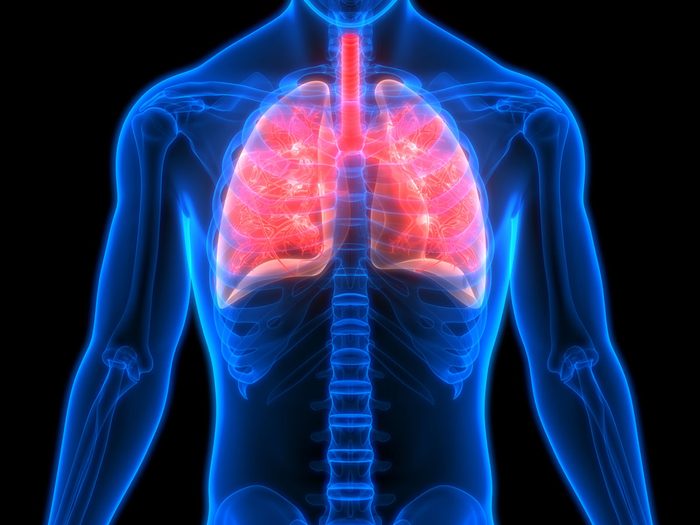Cancer in Canada
Research suggests that 1 in 2 Canadians will develop cancer in their lifetime.
Lung cancer is the leading cause of cancer-related deaths, causing more deaths among Canadians than the other three major cancer types (breast, colorectal and prostate) combined. (If you haven’t quit smoking yet, read this.) It also results in 14 percent of all new cancer cases. Despite this large impact, there has been a substantial drop in the lung cancer death rate (especially for men) over the past 25 years, which has driven a decline in the overall cancer death rate.
Males are diagnosed with cancer slightly more often than females — 45 percent of all males develop cancer in their lifetime, compared to 43 percent of all females — with prostate cancer and breast cancer being the most frequently diagnosed.
Read on to find out which provinces and territories have the highest risk and the lowest.

Nunavut: Lowest new cancer rate in Canada
Estimated new cancer rate: 226.3 per 100,000 people (85 new cases)
Estimated cancer deaths: 318.9 per 100,000 (55 deaths)
While this territory has the lowest rate of new cancer in Canada, the mortality rate in Nunavut is the third highest in the country. The top two causes of cancer death in this territory — lung cancer and colorectal cancer — are generally higher than Canadian averages but there are not a lot of reliable statistics for this territory (the most recent data is from 2017). Access to specialist medical care and screening likely has an impact on cancer diagnosis and survival rates in more remote regions of the country.
(Related: What If No One Believed You Were Sick?)
Northwest Territories: Second lowest new cancer rate in Canada
Estimated new cancer rate: 378.6 (170 new cases)
Estimated cancer deaths: 200.9 per 100,000 (75 deaths)
Northwest Territories has the second lowest estimated rate of new cancer cases in Canada The territories are also projected to have an increase in population over the age of 65, so this will increase their cancer rate moving forward. According to Let’s Talk About Cancer Northwest Territories, lung, colorectal, breast, and prostate cancer are the most frequent causes of death from cancer among NWT residents.

Yukon: Third lowest new cancer rate in Canada
Estimated new cancer rate: 390.5 per 100,000 (155 new cases)
Estimated cancer deaths: 237.4 per 100,000 people (85 deaths)
This territory has the third lowest new cancer rate in the country, but the highest death rate in Canada. According to an article from the Whitehorse Star, one in three deaths in the Yukon are cancer-related. Not only that, but between 2008 and 2012, the number of cancer deaths in the Yukon was 21 percent higher than expected compared to national rates. Lung cancer is also the leading cause of cancer deaths in the territory.
British Columbia: Fourth lowest new cancer rate in Canada
Estimated new cancer rate: 420.035 per 100,000 (27,400 new cases)
Estimated cancer deaths: 218.9 per 100,000 (11,100 deaths)
British Columbia has the fourth lowest new cancer rates in Canada. The mortality rate for lung cancer in British Columbia is lowest for both males and females. According to the Canadian Cancer Society, B.C. has historically lower cancer rates due to its citizens smoking less, being more active and eating healthier. This western province has one of the leading cancer diagnosis programs and they are a leader in early detection.
(Related: These Are the Worst Canadian Cities for Air Pollution)

Alberta: Fifth lowest new cancer rate in Canada
Estimated new cancer rate: 487.4 per 100,000 (21,300 cases)
Estimated cancer deaths: 164.7 per 100,000 (7,200 deaths)
This province has the fifth lowest estimated rate of new cancer cases. Cancer accounts for 27 percent of all deaths in the province for all ages, making it the second leading cause of death in Alberta (after circulatory system diseases, which accounts for 30 percent of all deaths). But Alberta may soon see a rise in cancer cases (along with the Territories) as statistics predict an increase in people over the age of 65 in the future. A report from The Alberta Health Technologies Decision Process found that cases of esophageal cancers in have increased, likely due to rising obesity rates.
Saskatchewan: Sixth lowest new cancer rate
Estimated new cancer rate: 511 per 100,000 (6000 new cases)
Estimated cancer deaths: 208.6 per 100,000 (2,450 deaths)
This province has the sixth lowest new cancer rate in Canada. It is also estimated to have a lower than average aging population, which may positively affect cancer rates in the future. Saskatchewan has an increasing rate of one of the most preventable cancers, melanoma, but the province has recently passed laws in regards to tanning bed usage for minors which may reduce risk factors.
(Related: I Was Diagnosed with Stage 3 Colon Cancer at Age 34)

Manitoba: Seventh lowest new cancer rate
Estimated new cancer rate: 518.6 per 100,000 (7,100 new cases)
Estimated cancer deaths: 215.4 per 100,000 (2,950 deaths)
Like many other places in Canada, Manitoba’s aging population is estimated to be growing and thus their cancer rate is projected also increase by nearly 50 percent by 2025, according to the Manitoba government. A 2010 report also showed that 55 percent of Manitobans are overweight or obese and 27 percent smoke, all of which can increase the risk of cancer.
Ontario: Sixth highest new cancer rate
Estimated new cancer rate: 617.7 per 100,000 (90,000 new cases)
Estimated cancer deaths: 206.6 per 100,000 (30,100 deaths)
Ontario has one of the lowest lung cancer mortality rates in Canada, which is connected to a lower rate of smoking in this province. Ontario also has a relatively high survival rate for both colorectal and prostate cancers. Uterine cancer is expected to see an increase in new cases in Ontario and B.C., more than other provinces, which may have to do with an expected increase in population. A report from March 2016 from Cancer Care Ontario shows that Indigenous people, especially those living on reserves, have a much higher prevalence of cancer risk factors than non-Indigenous Ontarians.
(Related: This Is What Skin Cancer Looks Like)

PEI: Fifth highest new cancer rate
Estimated new cancer rate: 630.8 per 100,000 (990 cases)
Estimated cancer deaths: 242.1 per 100,000 people (380 deaths)
Lung cancer mortality rates are amongst the highest in the Atlantic provinces, due to a traditionally higher rate of smoking. Bladder cancer predominantly affects Canadians over the age of 70 years and occurs more commonly in the Atlantic provinces. According to a 2012 report, cancer incidence in males in P.E.I. is 12 percent higher than the national average and is 10 percent higher for women. Getting screened regularly for cancers such as colorectal, breast and prostate cancers can help to identify cancers earlier and hence start treatment earlier.
Quebec: Fourth highest new cancer rate
Estimated new cancer rate: 669.4 per 100,000 (56,800 cases)
Estimated cancer deaths: 263.9 per 100,000 (22,400 deaths)
Smoking prevalence in the province of Quebec has led to higher lung cancer rates. The lung cancer mortality rates in this province, along with the Atlantic provinces are higher than the national average. In fact, Quebec is the only province where lung cancer is more prevalent than prostate cancer in males.
(Related: 7 Cervical Cancer Risks Every Woman Needs to Know About)

New Brunswick: Third highest new cancer rate
Estimated new cancer rate: 669.38 per 100,000 (5,200 cases)
Estimated cancer deaths: 271.6 per 100,000 (2110 deaths)
Smoking is a major preventable cause of cancer and New Brunswick residents average a smoking rate of 22 percent, slightly more than the national average of 20 percent. Only 36 percent of New Brunswickers reported having the five daily servings of fruits and vegetables recommended by the World Health Organization. (The Canadian national average of this consumption is 40 percent.) The activity level of New Brunswickers was 25 percent, one of the lowest reported in the country, and this province has one of the highest reported obesity rates at 59 percent. All these factors could affect outcomes. New Brunswick does has a lower than average mortality rate for prostate cancer.
Nova Scotia: Second highest new cancer rate
Estimated new cancer rate: 710.3 per 100,000 (6,900 cases)
Estimated cancer deaths: 303.68 per 100,000 (2950 deaths)
Nova Scotia has the second highest rate of new cancer in Canada and the second highest rate of estimated cancer deaths. Nova Scotians also have some of the highest rates of melanoma among males and females in the country. Increased screening programs and awareness can lower the risk of some of these cancers, which are treatable if caught early on.
(Related: What Doctors Want You to Know About Breast Cancer)

Newfoundland & Labrador: Highest rate of new cancer in Canada
Estimated new cancer rate: 738.2 per 100,000 (3850 cases)
Estimated cancer deaths: 312.53 per 100,000 (1630 deaths)
Newfoundland and Labrador has the highest incidence rates of cancer per capita in Canada. The Canadian Cancer Society expects rates of esophageal cancer to rise substantially in the next twelve to fifteen years. Atlantic provinces also historically have a high rate of smoking, which can contribute to the lung cancer cases. The cancer rates in Newfoundland are expected to rise, partially due to the aging population in this province.
How to Reduce Your Risk of Cancer
There are things you can do to help reduce your risk of developing cancer. The Canadian Cancer Society recommends reducing your alcohol consumption, getting regular physical activity, quitting smoking, maintaining a healthy weight, protecting yourself from the sun and avoiding tanning beds and eating a diet rich in fruits and vegetables. Smoking causes an estimated 85 percent of all lung cancers-either by directly smoking or from exposure to second-hand smoke. Taking measures to quit, such as signing up for a program or encouraging your loved ones to do the same can positively influence your overall cancer risk.
Next, here are 3 cancers on the rise in Canada and what you should know to protect yourself
